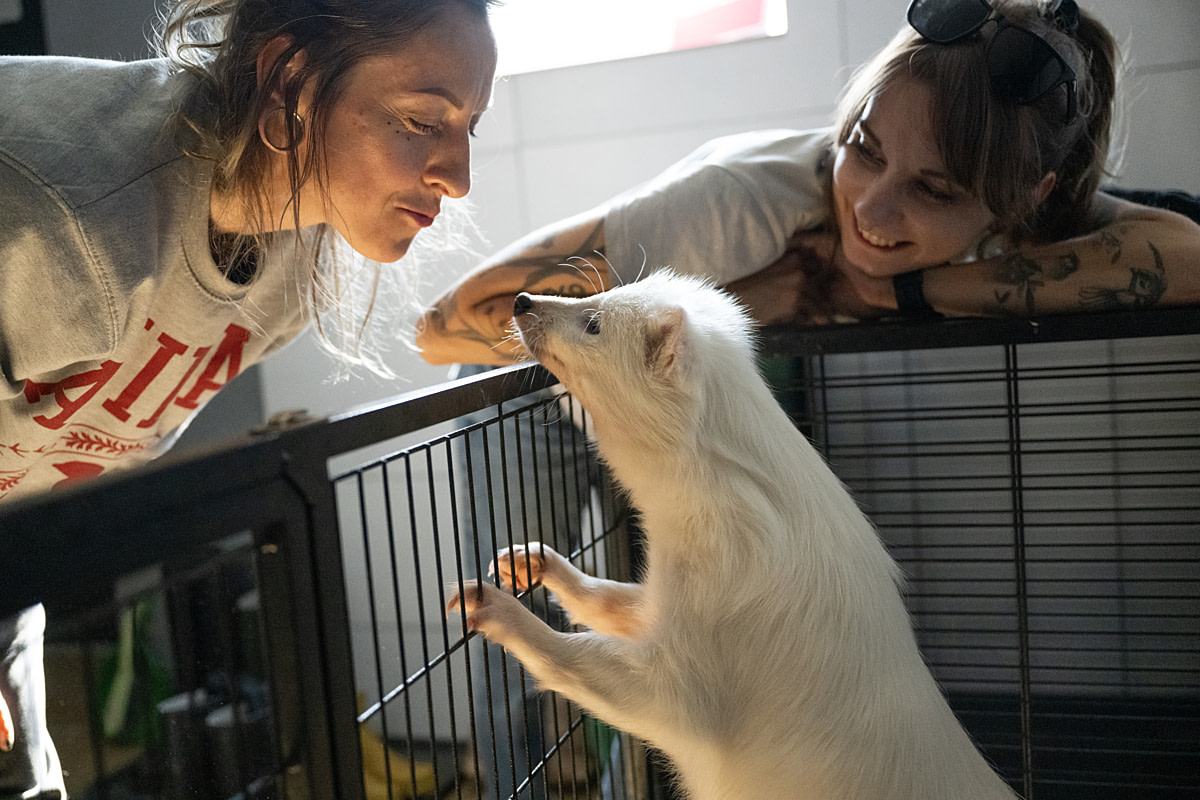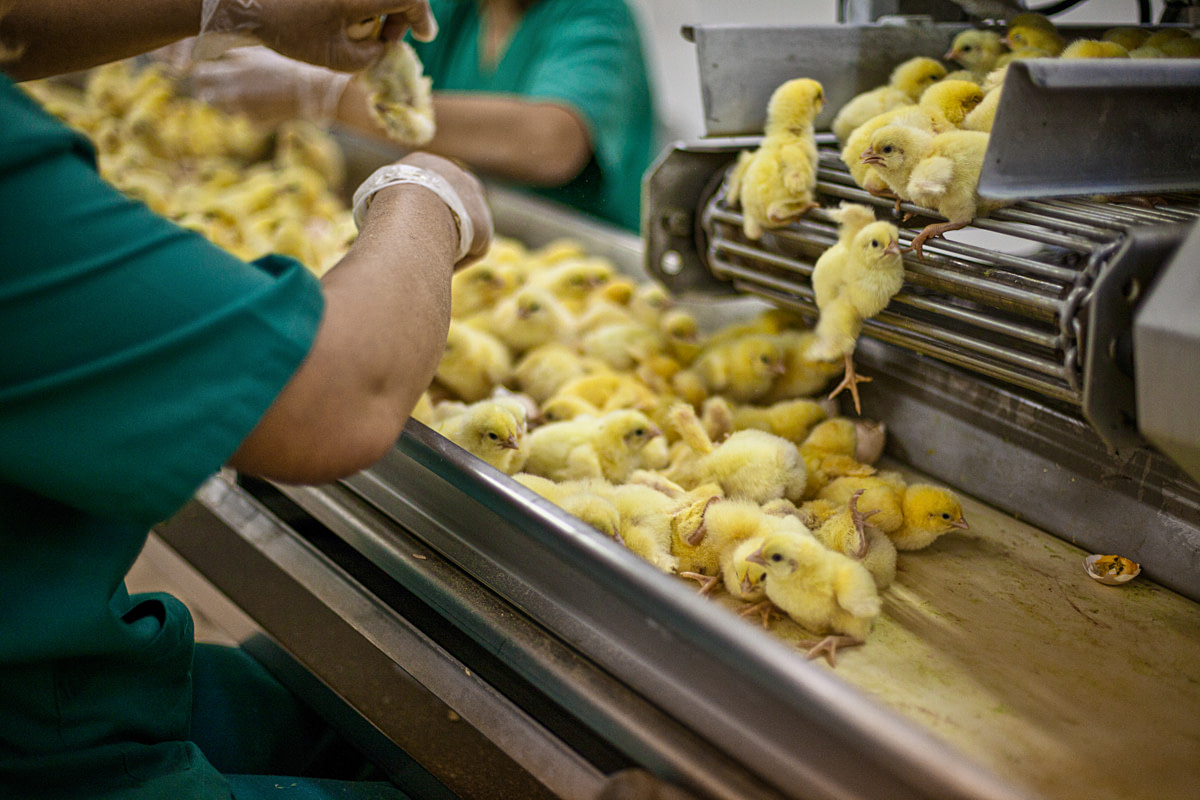On an industrial pig farm, a sow chews repetitively on the metal bars of her gestation crate. Quebec, Canada, 2022.
Jo-Anne McArthur / We Animals
Picture this: a journalist files a story on gestation crates. The writing is sharp, the facts undeniable. But the photo? A piglet in a sunlit field. The words say captivity, but the image says freedom, and the impact of the piece evaporates in an instant.
This is an image selection fail, and we see it every day.
Generic image banks promise everything. Type “pig” into the search bar and you’ll get thousands of results … most of which will be filler and clichés.
That’s why we built the world’s most extensive animal photojournalism stock platform for those covering animal stories. The We Animals Stock Site is an ever-growing collection of 35,000+ photos and videos taken in factory farms, slaughterhouses, fur farms, roadside zoos and sanctuaries. Every high-quality image is vetted, fact-checked, captioned, and ready for download, often for free. (That’s right, free. Did you know our images are available to those helping animals at zero cost?)

An activist documents conditions for hens in an egg-laying barn. Spain, 2017.
Jo-Anne McArthur / Animal Equality / We Animals

Red-feathered native chickens being unloaded from trucks at a slaughterhouse. Taipei, Taiwan, 2019.
Jo-Anne McArthur / We Animals

A close-up underwater view of a crowded group of tilapia on an Indonesian fish farm, about to be harvested from the floating cage they live in. Indonesia, 2021.
Lilly Agustina / Act For Farmed Animals / We Animals
The Difference Is Truth
We don’t stage idyllic barnyard scenes or use AI-generated or manipulated images. What you see is what happened.
The Difference Is Curation
When we choose a visual, it meets the highest technical standards and tells a story. Each image is selected for its ability to evoke emotion, reveal rarely seen truths, and show what life is really like for an individual animal. This level of curation means you don’t waste time wading through filler. Instead, you can quickly find images that are relevant, credible, and emotionally resonant.
Every image in the We Animals stock platform is handpicked by people who understand animals and farming systems. Our captions and descriptions are meticulously researched, fact-checked, and written to provide context you can trust.

A red fox at a fur farm in Quebec, which has since been closed down. Quebec, Canada, 2014.
Jo-Anne McArthur / #MakeFurHistory / We Animals

Investigator and animal advocate Bogna Wiltowska (right) and a colleague interact with Buba, a female white raccoon dog rescued from a fur farm the previous night. Poland, 2024.
Jo-Anne McArthur / Otwarte Klatki / We Animals

A lone duck looks through the slats of the tiny cage she is confined to at a duck egg farm in Indonesia. Indonesia, 2021.
Haig / Act for Farmed Animals / We Animals
NGOs & campaigners: Strengthen your advocacy with images that move people
Social media influencers: Stand out with visuals that spark honest conversation
Teachers & students: Bring lessons and research to life with documentary truth
Journalists & academics: Back up your reporting with credible, fact-based imagery
The Difference Is Quality
Historically, the only way to see hidden animals or the inside of factory farms was through shaky hidden-camera footage or grainy stills. While these visuals are powerful, they’re often not high-quality enough for a billboard campaign or book cover.
We’ve changed that. Today, the We Animals Stock Site offers not only truth, but quality: high-resolution visuals ready for global media and campaigns. The kind of visuals that can compete with glossy PR, and win.
We represent sought-after, globally award-winning photojournalists (Wildlife Photographer of the Year, BigPicture Natural World Photography Competition, COP26 Photography Competition and Bird Photographer of the Year, among others).
The Difference Is Integrity
We pay our photographers, prioritize their safety, and work to mentor the next generation of animal photojournalists. Every photograph is a real moment, witnessed and documented by a photojournalist who was there.

An Eastern grey kangaroo and her joey who survived the forest fires in Mallacoota. Mallacoota Area, Australia, 2020.
Jo-Anne McArthur / We Animals

A fisherman carries a shark at a market in a region that’s one of the largest exporters of shark fin to China. Lombok, Indonesia, 2013.
Paul Hilton / Earth Tree Images / HIDDEN / We Animals Media

Workers sort hours-old chicks on a conveyor belt at a chicken hatchery. The hatchery will vaccinate the healthiest chicks. Spain, 2011.
Luis Tato / Animal Equality / We Animals
The Difference is Reputation
Our images appear in influential publications such as National Geographic, The Guardian, Canadian Geographic, Vox, and more, and in exhibitions, documentaries, campaigns, billboards and textbooks.
Accessible, Affordable, and Mission-Driven
And the best part? These images are 100% free for anyone working to help animals such as activists, NGOs, and educators, and very reasonably priced for commercial use.
As a non-profit, every licensing dollar goes back into documenting animal stories, exposing cruelty, and training future animal photojournalists.
Tell Stronger Stories
The image you choose isn’t decoration. It sets the tone, signals credibility, and either strengthens or weakens your message. In a market overflowing with generic content and AI visuals, credibility matters more than ever. Convenience is easy, but truth is what cuts through the noise and really moves people.
If you want truth and quality in your animal images, we invite you to start using the world’s largest animal photojournalism stock collection today.
Visit the We Animals stock platform to explore and download images and videos from our collection of 35,000+ visuals. Subscribe to our Stock Alerts for monthly updates on the latest visuals available.




